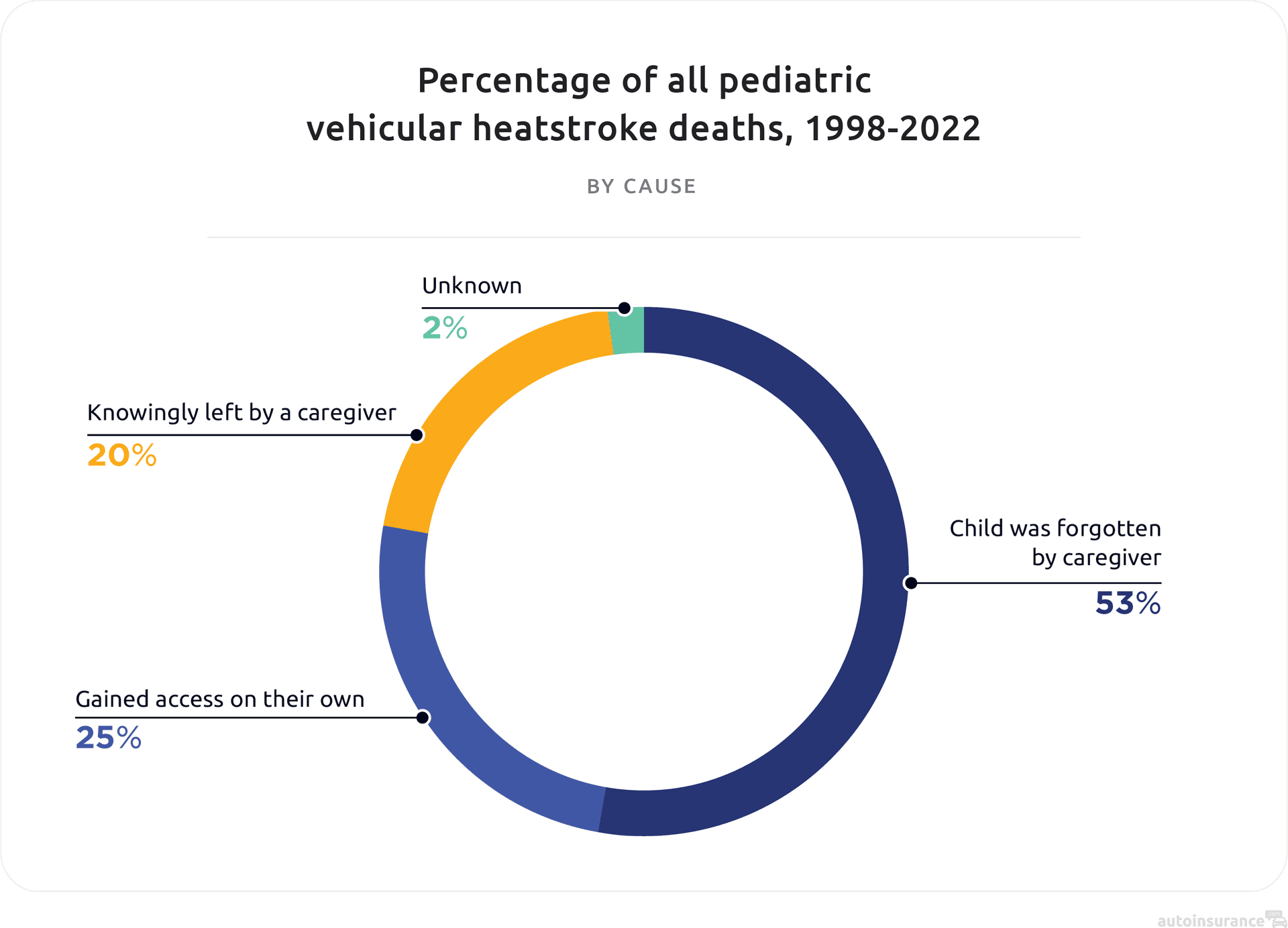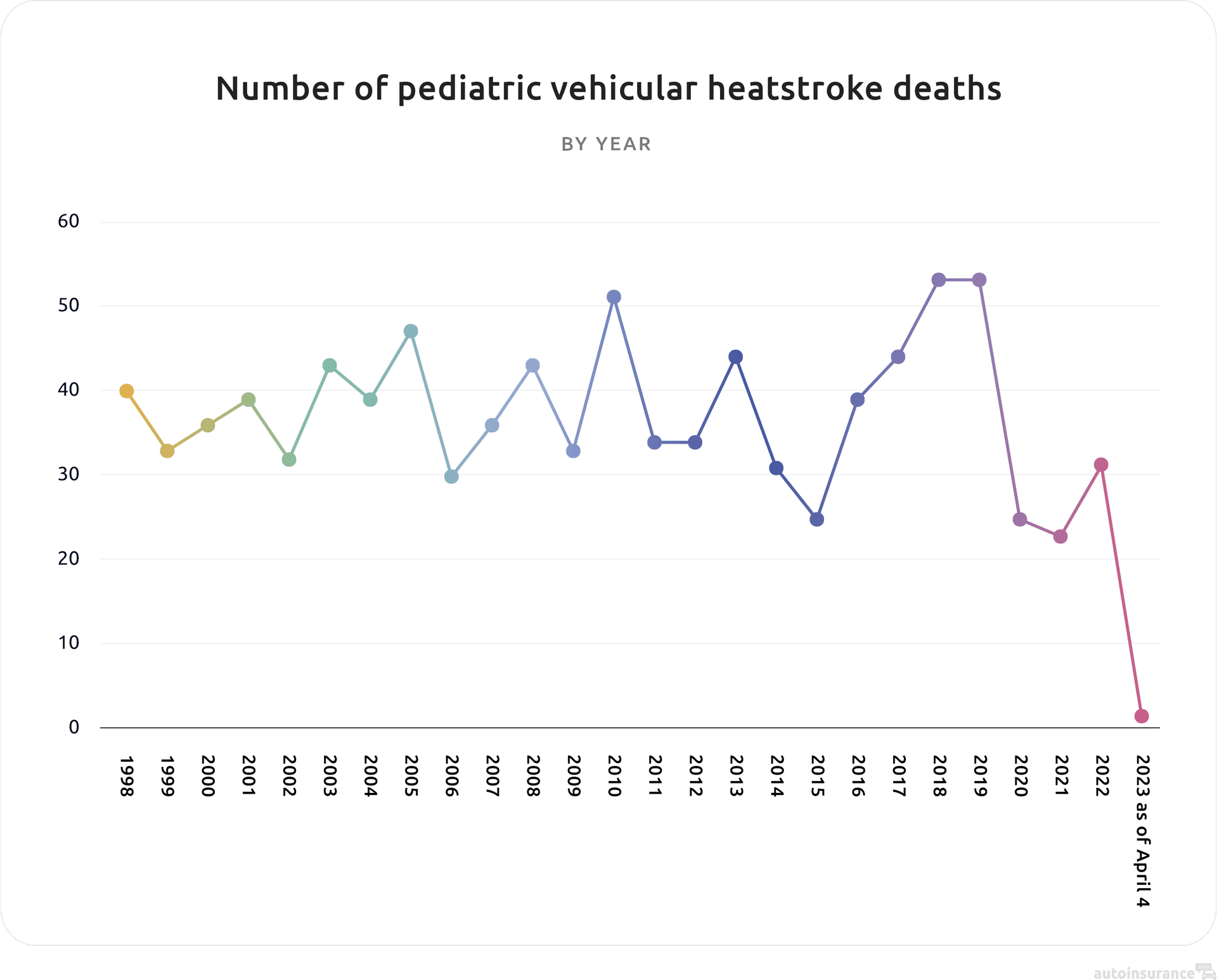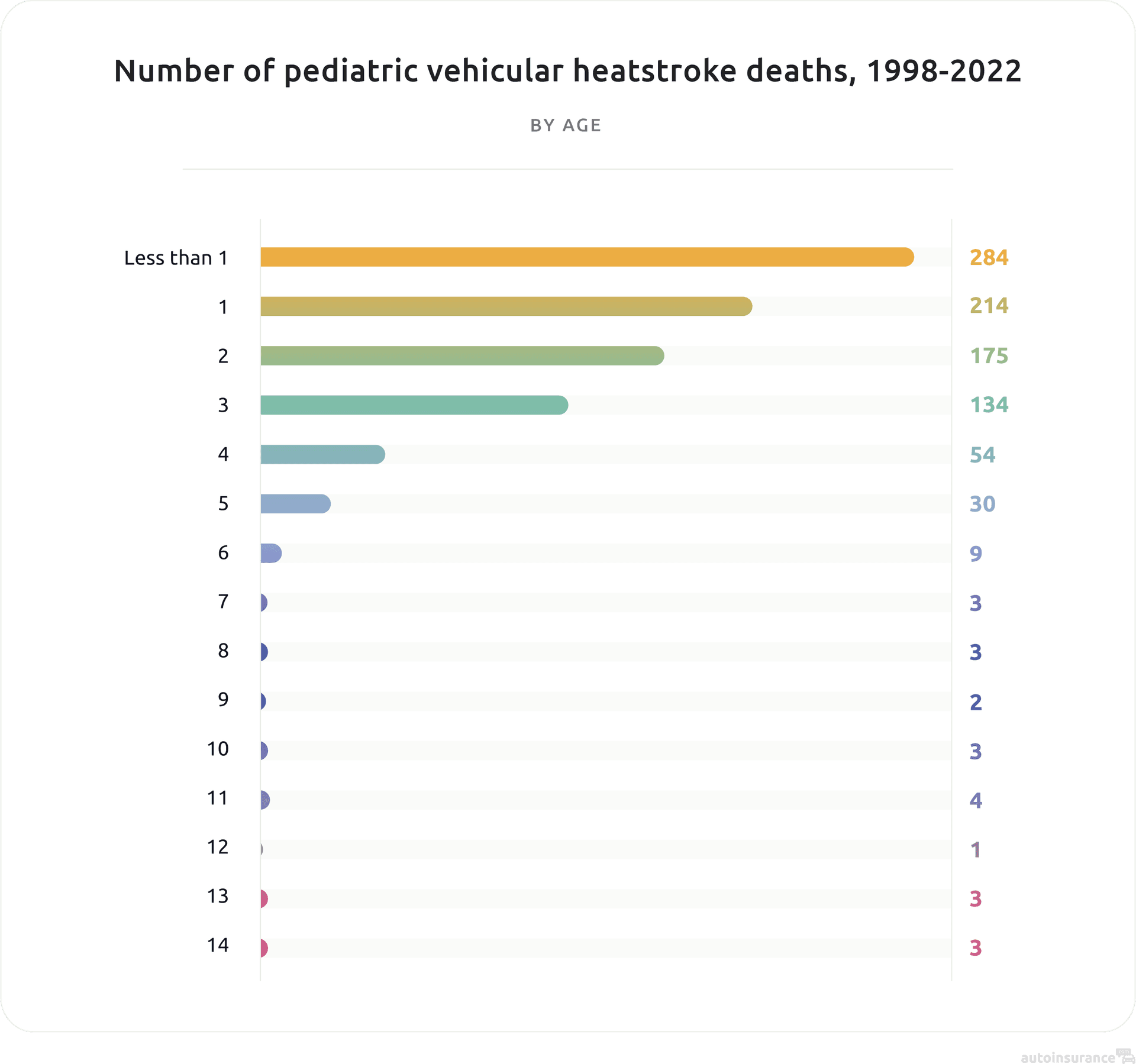

Hot Car Safety Facts and Statistics
Children are especially at risk of dying in hot cars as they heat up three to five times faster than adults.
Compare quotes from top providers

You know that feeling when you open your car door on a sweltering summer day only to enter what feels like an oven? Now imagine being trapped in there with no way to escape. While most adults would be able to get out of the vehicle easily, so long as they’re conscious, many children, younger kids in particular, aren’t so lucky. In 2022, 33 children died of pediatric vehicular heatstroke (PVH) after being left in hot cars.
The good news is that PVH deaths are entirely preventable and require one thing: never leaving your kid alone in a car, no matter the outside temperature or how long you’ll be gone.
Hot Car Safety Facts
Here’s what you need to know to prevent PVH, which is completely under your control.
How People Die From Heatstroke
If someone’s core body temperature gets too high, measuring 104 degrees Fahrenheit or more, they risk overwhelming their thermoregulatory system. If their body temperature reaches 107F, it results in death from heatstroke.
People may think leaving someone in a car couldn’t possibly result in heatstroke. But in just 10 minutes, a car can increase in temperature by as much as 20F (and rolling down the window makes no difference).
This is true even if you’re parked in shady areas or when the outside temperature is 80F or less. An 80 percent of the temperature increase can occur in the first 10 minutes, so leaving your child in a hot vehicle for even a few minutes can be lethal.
Risk Factors
The majority of PVH deaths occur when a parent or caregiver forgets a child is in the car and leaves them locked inside alone; this is also known as “forgotten baby syndrome.” However, sometimes, children let themselves into cars and, sometimes, caregivers think it’s OK to leave kids in cars unattended and do so purposely. The below data from the United States Department of Transportation shows the most common causes of PVH deaths.1

Myths
Just as there are auto insurance myths, there are myths surrounding hot car safety, as well. Let’s start debunking:
- It’s OK to leave kids in a car for a short period of time: You may not think running into a store for a few minutes while your toddler is in the car’s backseat is a big deal. However, children’s body temperatures rise three to five times faster than adults, making every minute count.
- It’s fine to leave kids in the car if it’s not hot out: Even if it’s only 70F outside, a car’s internal temperature can reach over 115F. Although most PVH deaths occur in the summer, they’re possible in any temperature 57F or warmer.
- It’s impossible to forget that kids are in the car: Child care is difficult. Parents are tired, distracted and stressed out, making it entirely possible to forget that their kids are in the car. Especially with rear-facing car seats or sleeping children, it’s a mistake many parents have made, unfortunately. Most parents who forget their kids are in the cars first forget to drop them off at preschool or day care and these incidents are most likely to occur on Thursdays and Fridays, at the end of the long workweek.
- Your car is light-colored and, therefore, will remain cool: It’s true that cars with darker colors absorb more light, making them heat up faster than cars painted with lighter colors that reflect light. For example, white and silver cars reflect about 60 percent of sunlight, staying cooler than dark cars. That said, you shouldn’t leave your kid in any vehicle unattended, even if it’s light-colored.2
- Kids cannot access cars on their own: If you leave the keys out and the children unattended, your kids can access cars on their own and get stuck in them. This cause of PVH deaths is most likely to occur on Sundays.
- You can leave your kids in the car if your windows are down: Unfortunately, rolling down your window won’t slow the heating process or decrease the temperature.3
Good Samaritan Laws by State
Every state and Washington, D.C., has some form of Good Samaritan law, which applies to people voluntarily helping others in emergencies and protecting these volunteers from being sued in civil court for damages, injuries and deaths. In the case of leaving kids in a hot car, a Good Samaritan would either break the window, try to find the parent or call the police to save the child from a PVH death. For Good Samaritan laws to apply, however, the following circumstances are required:
- It must be an emergency.
- The help must be voluntary.
- The victim consented to care if they are conscious and responsive. If the victim is unconscious and unresponsive, there is “implied consent” that allows for someone to help.4
- The care is free.
- The care is performed “in good faith.”
- The care is not gross negligence or willful misconduct, which we’ll define more below. However, it can be ordinary negligence, meaning the person tried but did not perform as a reasonable healthcare provider would.
Good Samaritan laws would not apply if:
- There is gross negligence, meaning the person did not follow the accepted standard of care and actions were “willful, wanton or even malicious.”
- It was not an emergency.
- The victim was responsive and did not consent to care.
- The person charged for their care.
- The care occurred in a hospital, clinic or doctor’s office (however, in Colorado, doctors in hospitals are protected as long as the care was performed outside of their normal scope of responsibilities, they had no duty to respond and they weren’t paid to respond).
In Rhode Island, Vermont and Minnesota, there are duty-to-act laws, where you are legally required to provide assistance to a person who needs emergency medical treatment.5
Good Samaritan laws allow people to save children from unnecessary PHV deaths without the risk of getting sued. However, the best way to save children from these deaths is for no one to leave them in hot cars in the first place.
How to Prevent Hot Car Deaths
Here are the best ways to prevent PHV deaths, according to the National Highway Traffic Safety Administration (NHTSA):
- Don’t leave your kids in a car unattended, even for a few minutes.
- If you see a kid in a vehicle unattended, first try to locate their parents. If you can’t and believe they are in a nearby store, have the store’s management make an announcement over an intercom system or call 911. In some cases, you may have to break a window to access the car and rescue the child.
- Before you leave your car, check for any kids, particularly sleeping babies.
- When you’re not using it, lock your car and hide your key fobs so that your kids can’t access them.
- Teach your kids that vehicles aren’t a place to play. They should only be in a vehicle if you are driving them somewhere.
- Teach kids that if they’re locked in a vehicle and can’t get out through the passenger doors, they should try the front driver’s-side door. If that is also locked, they should honk the horn for outside help.6
Hot Car Safety Statistics
Fortunately, PHV deaths are very rare, although they’re more common in warm places like Florida and Texas.
How Many People Leave Children in Hot Cars?
According to a 2014 survey of U.S. parents, 14 percent have intentionally left their infants, toddlers and kindergarteners in parked vehicles. For parents of children ages 3 and under, this percentage increased to 23 percent. Many parents may not be aware of the dangers of leaving kids in cars, even for short periods of time.
More troublingly, 11 percent of parents admitted to forgetting their kids in the car — and that was also true for 25 percent of parents of kids age 3 and under.7 While the majority of kids left in cars don’t die of heatstroke, it’s not worth the risk.
How Many Children Die of Heatstroke in Vehicles?
Jan Null, a certified consulting meteorologist at San Jose State University’s Department of Meteorology & Climate Science, has tracked every U.S. PVH death since 1998.8 While deaths in hot cars are rare, they’re more common in certain years and in certain states.
By Year
In 2022, the most recent year for which complete data is available, there were 33 PVH deaths in the U.S. While this is a 43 percent increase from the previous year, it is less than the average of 34 PVH deaths per year from 1998 to 2022. Deaths peaked in 2018 and 2019, with 53 deaths in each year, respectively.

By State
The state with the highest number of PVH deaths from 1998 to 2022 was Texas, which had 138 deaths, or an average of six deaths per year. Florida follows close behind, with 102 deaths over this 24-year period or an average of four per year.
| State | Number of pediatric vehicular heatstroke deaths, 1998-2022 | PVH deaths per 1 million kids under the age of 14 |
|---|---|---|
| Alabama | 31 | 34 |
| Alaska | 0 | 0 |
| Arizona | 43 | 32 |
| Arkansas | 19 | 33 |
| California | 56 | 8 |
| Colorado | 7 | 7 |
| Connecticut | 5 | 8 |
| Delaware | 2 | 12 |
| Florida | 102 | 29 |
| Georgia | 39 | 19 |
| Hawaii | 5 | 20 |
| Idaho | 8 | 22 |
| Illinois | 16 | 7 |
| Indiana | 15 | 12 |
| Iowa | 7 | 12 |
| Kansas | 14 | 24 |
| Kentucky | 23 | 28 |
| Louisiana | 36 | 40 |
| Maine | 2 | 10 |
| Maryland | 14 | 13 |
| Massachusetts | 4 | 4 |
| Michigan | 10 | 6 |
| Minnesota | 8 | 7 |
| Mississippi | 20 | 34 |
| Missouri | 27 | 24 |
| Montana | 3 | 16 |
| Nebraska | 3 | 8 |
| Nevada | 14 | 24 |
| New Hampshire | 0 | 0 |
| New Jersey | 15 | 9 |
| New Mexico | 11 | 28 |
| New York | 10 | 3 |
| North Carolina | 39 | 20 |
| North Dakota | 1 | 7 |
| Ohio | 22 | 10 |
| Oklahoma | 29 | 36 |
| Oregon | 4 | 6 |
| Pennsylvania | 13 | 6 |
| Rhode Island | 1 | 6 |
| South Carolina | 22 | 24 |
| South Dakota | 4 | 22 |
| Tennessee | 31 | 25 |
| Texas | 138 | 22 |
| Utah | 12 | 16 |
| Vermont | 0 | 0 |
| Virginia | 30 | 19 |
| Washington | 5 | 4 |
| Washington D.C. | 2 | 18 |
| West Virginia | 5 | 17 |
| Wisconsin | 9 | 9 |
| Wyoming | 1 | 9 |
When you look at the number of PVH deaths per capita, however, Louisiana has the highest rates, with 40 PVH deaths per 1 million children under the age of 14 from 1998 to 2022.
By Age
Eighty-eight percent of PVH victims across 1998-2022 were ages 3 or under while the plurality, 31 percent, were babies younger than 1-year-old. It’s easiest to forget babies in cars as they might be sleeping or sitting in rear-facing seats.

The chances of a child dying of heatstroke in a car greatly decrease with age, going down to almost zero after age 6.
Are Hot Car Deaths Covered by Insurance?
You might be surprised to learn that the way car insurance works, acts of negligence are rarely covered. If you leave your child in a hot car and they die, you won’t receive a death benefit. Car insurance doesn’t cover other issues of negligence, either, such as not maintaining your vehicle properly or driving distracted. Just because deaths or injuries occur in cars does not mean you are entitled to a payout from your car insurance provider. Check your policy to read about the specific rules surrounding negligence.
Conclusion
Avoid the pain and heartache of pediatric vehicular heatstroke by never leaving your kids in the car and always making sure they don’t have access to the car when you’re not around. Unlike other risks associated with car ownership, such as natural disasters and carjackings, you can entirely prevent kids from dying of heatstroke in vehicles.
Methodology
To compile this report, we used data from third-party organizations such as:
- Berkeley Lab Energy Technologies Area
- Council of Residency Directors in Emergency Medicine
- KidsAndCars.org
- NHTSA
- National Library of Medicine
- Safe Jose University Department of Meteorology & Climate Science
- Safe Kids Worldwide
- U.S. Department of Transportation
Frequently Asked Questions
How long can you stay in a hot car?
How long you can stay in a hot car depends on your age, the outside temperature and the color of your vehicle. Ideally, you don’t stay in a hot car for long as vehicles can heat up by as much as 20F in 10 minutes, representing 80 percent of the total temperature increase.
If your core temperature reaches 107F, it can be lethal and this is possible in outside temperatures of 57F or higher. Also, keep in mind that children heat up at rates three to five times faster than adults, so it’s best not to ever leave kids in hot cars, even for a short time period.
What is the forgotten baby syndrome?
According to the National Institutes of Health, forgotten baby syndrome occurs when a child care provider forgets a child in a parked car. This can result in child hot car deaths.
Citations
Heatstroke Prevention Toolkit. Traffic Safety Marketing. (2023).
https://www.trafficsafetymarketing.gov/search?keywords=heatstrokeCool Colors for Cars Could Improve Fuel Economy, Reduce Emissions. Berkeley Lab. (2011, Oct 17).
https://buildings.lbl.gov/news/11089/cool-colors-for-cars-could-improve-fuel-economy-reduce-emissionsChild Hot Car Dangers Fact Sheet. Kids and Car Safety. (2023).
https://kidsandcars.wpenginepowered.com/wp-content/uploads/2020/01/Heatstroke-fact-sheet.pdfGood Samaritan Laws. National Library of Medicine. (2022, Sep 12).
https://www.ncbi.nlm.nih.gov/books/NBK542176/Good Samaritan Laws Summary Handout. Cordem. (2023).
https://www.cordem.org/siteassets/files/curricular-toolkit/good.samaritan/good.samaritan.laws.summary.handout.pdfYou Can Help Prevent Hot Car Deaths. National Highway Traffic Safety Administration. (2023).
https://www.nhtsa.gov/child-safety/you-can-help-prevent-hot-car-deathsNEW STUDY: 14% OF PARENTS SAY THEY HAVE LEFT A CHILD ALONE INSIDE PARKED VEHICLE DESPITE THE RISKS OF HEATSTROKE. Kids Safe Worldwide. (2014, Apr 29).
https://www.safekids.org/press-release/new-study-14-parents-say-they-have-left-child-alone-inside-parked-vehicle-despiteHeatstroke Deaths of Children in Vehicles. NoHeatStroke.org. (2023, Apr 3).
https://www.noheatstroke.org/